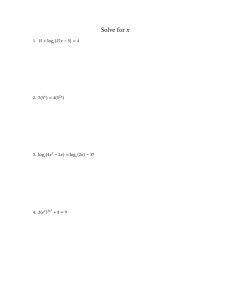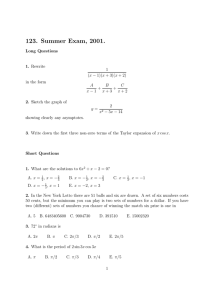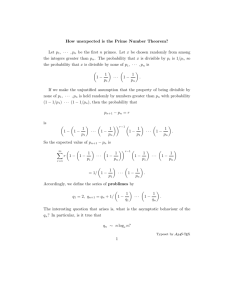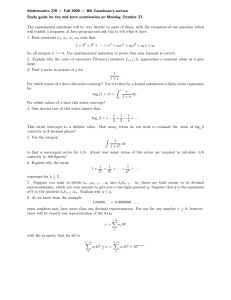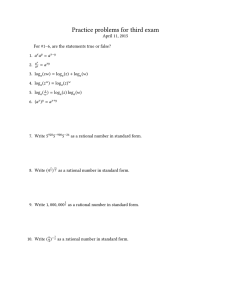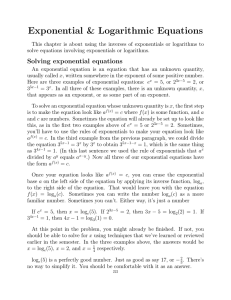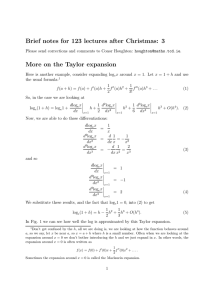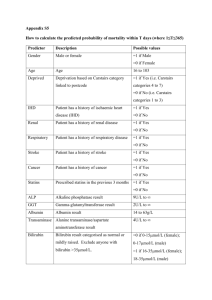Exponential & Logarithmic Equations
advertisement
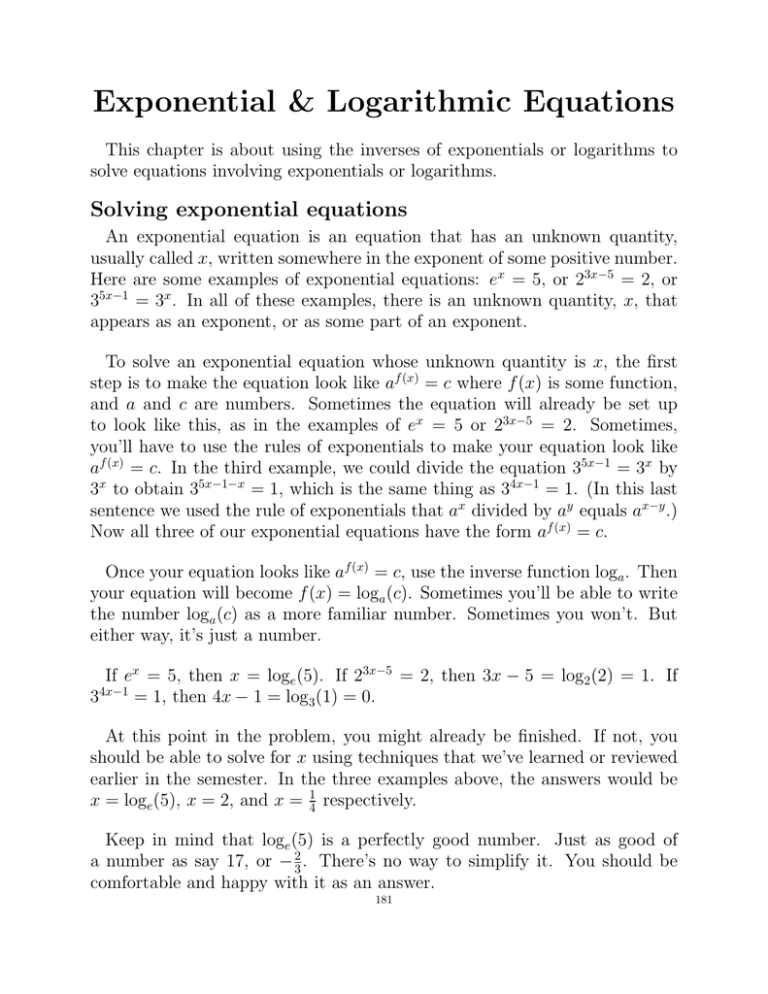
Exponential & Logarithmic Equations This chapter is about using the inverses of exponentials or logarithms to solve equations involving exponentials or logarithms. Solving exponential equations An exponential equation is an equation that has an unknown quantity, usually called x, written somewhere in the exponent of some positive number. Here are some examples of exponential equations: ex = 5, or 23x−5 = 2, or 35x−1 = 3x . In all of these examples, there is an unknown quantity, x, that appears as an exponent, or as some part of an exponent. To solve an exponential equation whose unknown quantity is x, the first step is to make the equation look like af (x) = c where f (x) is some function, and a and c are numbers. Sometimes the equation will already be set up to look like this, as in the examples of ex = 5 or 23x−5 = 2. Sometimes, you’ll have to use the rules of exponentials to make your equation look like af (x) = c. In the third example, we could divide the equation 35x−1 = 3x by 3x to obtain 35x−1−x = 1, which is the same thing as 34x−1 = 1. (In this last sentence we used the rule of exponentials that ax divided by ay equals ax−y .) Now all three of our exponential equations have the form af (x) = c. Once your equation looks like af (x) = c, use the inverse function loga . Then your equation will become f (x) = loga (c). Sometimes you’ll be able to write the number loga (c) as a more familiar number. Sometimes you won’t. But either way, it’s just a number. If ex = 5, then x = loge (5). If 23x−5 = 2, then 3x − 5 = log2 (2) = 1. If 34x−1 = 1, then 4x − 1 = log3 (1) = 0. At this point in the problem, you might already be finished. If not, you should be able to solve for x using techniques that we’ve learned or reviewed earlier in the semester. In the three examples above, the answers would be x = loge (5), x = 2, and x = 14 respectively. Keep in mind that loge (5) is a perfectly good number. Just as good of a number as say 17, or − 23 . There’s no way to simplify it. You should be comfortable and happy with it as an answer. 181 Steps for solving exponential equations Step 1: Make the equation look like af (x) = c where a, c ∈ R and f (x) is a function. Step 2: Rewrite the equation as f (x) = loga (c). Step 3: Solve for x. Example. Let’s solve for x if e3x−7 = 5ex−1 To perform Step 1, we can divide both sides of the equation by ex−1 . We’d be left with e3x−7 =5 ex−1 3x−7 But eex−1 = e3x−7−(x−1) = e2x−6 . So we’re really left with e2x−6 = 5 and that completes Step 1. Step 2 is to erase the exponential function in base e from the left side of the equation e2x−6 = 5 by applying its inverse, the logarithm base e, to the right side of the equation. To put it more simply, we rewrite e2x−6 = 5 as 2x − 6 = loge (5) Step 3 is to solve the equation 2x − 6 = loge (5) using algebra. We can do this by adding 6 to both sides of the equation and then dividing both sides of the equation by 2. We’ll be left with the answer x= * * * * * * loge (5) + 6 2 * 182 * * * * * * Solving logarithmic equations A logarithmic equation is an equation that contains an unknown quantity, usually √ called x, inside of2 a logarithm. For example, log2 (5x) = 3, and log10 ( x) = 1, and loge (x ) = 7 − loge (2x) are all logarithmic equations. To solve a logarithmic equation for an unknown quantity x, you’ll want to put your equation into the form loga ( f (x) ) = c where f (x) is a function √ of x and c is a number. The logarithmic equations log2 (5x) = 3 and log10 ( x) = 1 are already written in the form loga ( f (x) ) = c, but loge (x2 ) = 7 − loge (2x) isn’t. To arrange the latter equality into our desired form, we can use rules of logarithms. More precisely, add loge (2x) to the equation and use the logarithm rule that loge (x2 ) + loge (2x) = loge (x2 2x). Then the equation becomes loge (2x3 ) = 7, and that’s the form we want our logarithmic equations to be in. Once your equation looks like loga ( f (x) ) = c, use that the base a exponential is the inverse of loga to rewrite your equation as f (x) = ac . You might want to simplify the number that appears as ac in your new equation, but other than that, you’re done with exponentials and logarithms at this point in the problem. It’s time to solve the equation using techniques we used earlier in the semester. Let’s look at the three examples above. We would rewrite log2 (5x) = 3 as 5x = 23 = 8. Then we solve our new equation to find that x = 85 . √ √ We would rewrite log10 ( x) = 1 as x = 101 = 10. Since squaring is the inverse of the square root, we are left with x = 102 = 100. For the third equation, we had � loge (2x3 ) = 7. Rewrite it as 2x3 = e7 , and 7 then solve for x to find that x = 3 e2 . 183 Steps for solving logarithmic equations Step 1: Make the equation look like loga ( f (x) ) = c where a, c ∈ R and f (x) is a function. Step 2: Rewrite the equation as f (x) = ac . Step 3: Solve for x. Example. Let’s solve for x if loge (−x2 + 2x) = loge (x) + 4 To perform Step 1, we can subtract loge (x) from both sides of the equation to get loge (−x2 + 2x) − loge (x) = 4 2 Recall that loge (−x2 + 2x) − loge (x) = loge ( −x x+2x ) = loge (−x + 2). That means that loge (−x + 2) = 4 That’s the end of Step 1. Step 2 is to erase the logarithm base e from the left side of the equation loge (−x + 2) = 4 by applying the exponential function of base e to the right side of the equation. That is, we rewrite loge (−x + 2) = 4 as −x + 2 = e4 Step 3 is to solve the equation −x + 2 = e4 using algebra. Subtracting 2 and multiplying by −1 leaves us with the answer x = 2 − e4 * * * * * * * 184 * * * * * * Exercises Solve the following exponential equations for x. 1.) 103x = 1000 2.) 6(14x ) = 30 3.) 2ex = 8 4.) ex + 10 = 17 5.) (3x )5 = 27 x 6.) 5− 2 = 1 5 7.) 53x−4 = 125 8.) e2x = 2 ex e2 2 9.) e−x = ex+5 e−11 Solve the following logarithmic equations for x. 10.) log3 (x − 5) = 2 11.) loge (x) = −6 12.) loge (2x) = 24 √ 13.) loge ( x − 4) = 5 14.) log2 (x7 ) = 28 15.) log10 ((x + 1)−5 ) = −15 16.) 5 + loge (x3 ) = 11 17.) log2 (−x) − log2 (−x − 4) = 3 18.) log2 (x − 2) = −3 185
